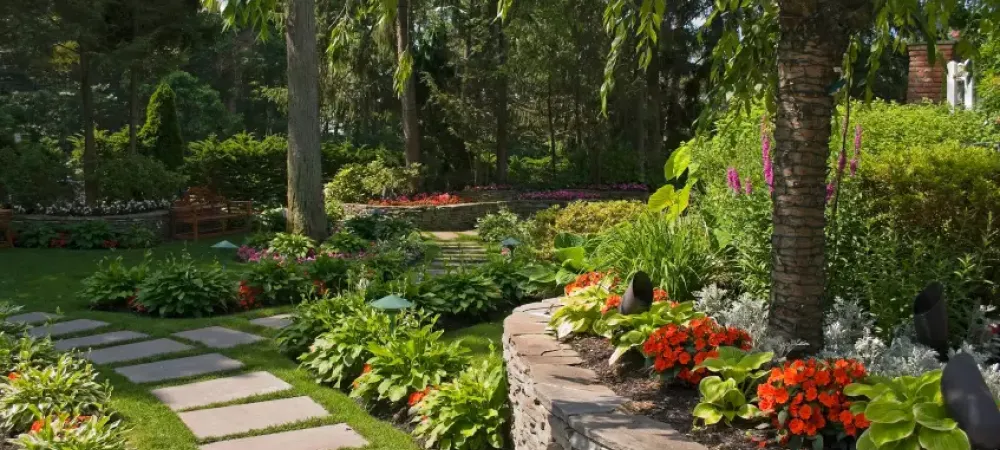6 Spring Landscaping Tips

Spring is nearly here! It’s time to get the mower tuned up, reattach the garden hose, and don your gardening gloves if you want a lush green yard. To kick off the start of spring, we’d like to share some handy landscaping tips to give you a head start.
Spring Landscaping 101
1. Be On Your A-Game With Lawn Care
For many homeowners, watering and mowing regularly, with a dash of fertilizer somewhere in there, is what constitutes good landscaping. And while all three of those are great, there’s a little more to it than that. Considering performing a soil test, so you know exactly what you’re dealing with in terms of soil pH. If your lawn leans to the acidic end of the spectrum, it won’t be receptive to fertilizer. This can easily be corrected with a lime application.
Knowing the chemical makeup of your lawn will help you determine which fertilizer blend is ideal. Most are composed of a blend of three different minerals: nitrogen (N), phosphorus (P), and potassium (K). When researching blends, you’ll see bags with a three-numbered ratio such as 4-4-4 or 2-5-3. These are the ratios of each of the aforementioned minerals. Each of these helps your lawn perform essential functions like storing nutrients, growing, and creating a healthy root system. Knowing your soil’s pH will help you make the correct choice. You can also purchase products known as weed-and-feeds—more on that in a moment.
2. Stop Weeds In Their Tracks
Nothing ruins the beauty of landscaping more than unsightly weeds. Consider adding a weed control granule to your yard. You can even purchase them in products known as “weed-and-feeds” that provide nourishment for your grass while eliminating any weeds. Whatever type of weed control product you choose, make sure you determine if it is “pre-emergent” or “post-emergent.” As you might have guessed, pre-emergent products will target weeds before they have a chance to germinate. Post-emergent is for those pesky stragglers that make it past the first line of defense.
When applying weed control to your front yard landscaping, the other thing to consider is whether the product is “selective” or “non-selective.” Selective herbicides will only target the unwanted weeds – not any flowers, trees, or shrubs. As such, it’s safe to apply to garden beds that may be overrun with weeds. You can rest assured your flowers will be unharmed. Non-selective herbicides are good for areas like the cracks in driveways and sidewalks. It really doesn’t matter what’s growing in your driveway because you don’t want plant life there, to begin with.
3. Know How To Mow
Depending on the size of your lawn, mowing can be quite time-consuming. It’s tempting to cut corners by setting your mower to the lowest height so you won’t have to mow as often. However, doing so can encourage weeds and pests to thrive on your lawn. Keeping your turfgrass at a height of two to three inches helps guard against weeds, pests, and is beneficial to the overall health of your lawn. And while you’re at it, consider removing the mower bag and trading it for the mulch attachment. If you mow at the correct height, the grass clippings won’t become too long and large to leave on the lawn. These clippings are natural – and free! – way to add nutrients to your lawn in the form of mulch.
4. What To Do About Water
Turfgrass needs about an inch of water a week – if you live in Ohio. Our Florida customers experience more humidity and consequently may not need to water as often. If it’s rained this week, consider waiting to set up the hose and sprinkler until the following week. Watering more often can oversaturate the grass. Watering deeply, but less often, is the ideal treatment for cool-season turfgrass.
5. Get A Handle On Grubs
Grubs are the larvae of Japanese beetles. They are c-shaped and white in color and dwell below the surface of the lawn. When spring arrives, they wake up from their winter slumber with a voracious appetite for turfgrass roots. As they feed on the roots of the grass, you’ll notice your lawn losing its color, and the turf will feel spongy or may even pull up easily. Applying grub control early on in spring will keep your landscaping healthy all season long.
6. Thatch That Grass
Thatch is what we call the build-up of organic material that has broken down: think lawn clippings, leaves, or other plant matter. Having some in the lawn is beneficial, but the turf will feel hard and compact when it becomes too thick. A thatching rake will make quick work of that build-up and allow nutrients, air, water, and sunlight to penetrate the earth more easily and reach the roots of your grass.
Check Lawn Care Off Your To-Do List
Give yourself peace of mind knowing your lawn is in good hands. It’s one less thing for you to take care of! If you seek spring lawn care in Ohio or southern Florida, look no further than Land Art Inc. Our multi-step lawn care program, weed control applications, and grub control measures keep your yard green and pest-free! To learn more or schedule an appointment, call 1-800-336-5296 or contact us online here. And for more tips and ideas, be sure to read our blog.
